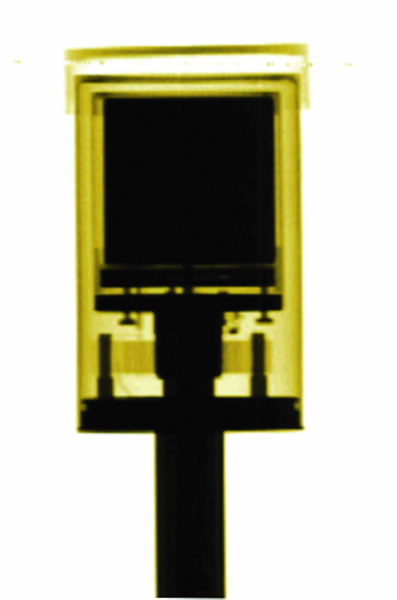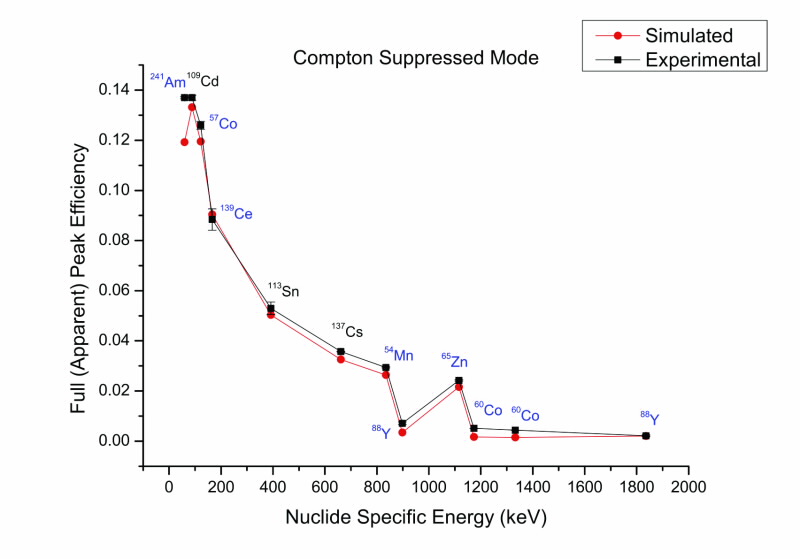Measuring radionuclides in the environment at very low concentration levels is of increasing importance to ensuring we have a proper means of monitoring the impact of nuclear activities on the environment.
Many aspects of environmental monitoring require very sensitive detection techniques for precise measurement of the very low levels of radionuclides found in the environment.
This need has driven the development of new detector instrumentation, which in turn has prompted the need for more complex techniques for instrument calibration. ANSTO has developed new techniques based on Monte-Carlo simulation to determine accurate calibrations of a specialised high-resolution gamma-ray spectrometer used to measure radionuclides at environmental levels in a variety of sample matrices and geometries.
Introduction to the technique used
High-resolution gamma-ray spectrometry is routinely used for measuring radionuclides in a variety of purposes. In environmental contexts the presence of radionuclides is typically at very low concentrations challenging the performance of traditional approaches.
Reducing the spectral background to allow better detection of small gamma-ray signatures in environmental samples can be achieved using Compton-suppression techniques [2]. Compton scattering is a type of scattering that gamma rays undergo in matter; its inelastic scattering results in a decrease in energy of a gamma-ray photon, called the Compton effect.
In the Compton-suppression approach the addition of a secondary outer detector to the normally employed spectroscopy inner detector allows for the detection of Compton-scattered photons which emerge from the inner detector. Anti-coincident circuitry allows these Compton-scattered events to be rejected from the measured spectrum thereby greatly improving the ability to identify gamma-ray peaks which would otherwise be hidden behind the Compton continuum.
The International Atomic Energy Agency and many practitioners have identified that the calibration of Compton-suppressed gamma-ray spectrometers for the various sample matrices and measurement geometries used for environmental samples is complicated, time consuming and costly [1].
We used Monte Carlo simulations as an alternative to empirical calibration to assess the correction factors specific to the detector design and overall energy
calibration of a Compton-suppressed spectrometer specific to radionuclides in environment contexts.
Detector specifications
Measurements were performed with a Comptonsuppressed reverse-electrode high-purity germanium (HPGe) detector (Model GR5022 from the company Canberra), specified as having a relative efficiency of 50.9% to a 3 inch by 3 inch NaI(TI) detector at 1.33 MeV. The components and dimensions of the HPGe detector were taken from manufacturer-provided documents.
A sketch of the HPGe detector, is shown in Fig. 1 and an X-ray radiograph of the detector is shown in Fig. 2. The reverse-electrode HPGe detector, which acts as the primary spectrometer, is surrounded by two NaI(TI) detectors in the form of an annulus and plug.
The plug is positioned above the inner detector adjacent to the annulus. The detector annulus is further contained in a thin aluminium holder with an inner and outer radius of 41.25 mm and 140.5 mm, respectively.
The full length of the surrounding annulus is 162.5 mm. The entire suppression system is placed in a graded lead case shield (w115 mm thick) with an inner copper and tin lining (each w1.5 mm thick) to protect against environmental radiation (e.g. cosmic rays, building materials radiation).
 |
| Schematic illustration of the HPGe detector not drawn to scale. |
Simulation of detection processes
The Compton-suppressed HPGe detector system as described was modelled using the Monte Carlo simulation package Geant4 (version 9.4) [3]. The Geant4 Low Energy Electromagnetic Physics processes based on the Livermore libraries, valid for energies of 250 eV-100 GeV, were used to model the photon interactions within the detector.
The physics processes activated included Compton scattering, Rayleigh scattering, pair production and the photoelectric effect for photons. Bremsstrahlung and ionisation processes for secondary particles were also activated.
The gamma-emitting radionuclides were generated using the radioactive-decay module [4], which allows the user to generate all possible decay components emitted for a particular radionuclide.
For comparison of the simulated results, the detector system energy calibration was conducted using a traceable multi-nuclide standard source (QSA Global RF929), which covers a gamma-ray energy range of 60 to 2000 keV.
The standard sample configuration used was a 65 mm diameter plastic petri-dish containing the compacted soil sample, positioned directly on the detector end-cap.
 |
| X-ray radiograph taken of the HPGe detector to verify the geometric structure. |
The calibration
The detection efficiencies for the standard source sample, RF929, were calculated with Monte Carlo simulations for the suppressed and unsuppressed modes of operation and compared to the experimental efficiencies (see Fig. 3 for the suppressed mode data).
The experimental and the simulated values agree relatively well for high energies but deviate at lower energies. Low-energy photons would be more susceptible to absorption in the inactive detector components and sample. If these components are not correctly modelled, it can affect the calculated efficiencies.
The summation effects within the HPGe detector seem to be mostly well accounted for by the Geant4 radioactive-decay models for the unsuppressed mode.
The simulations show that the full energy peak efficiency in the suppressed detector mode is radionuclide dependent. This is largely due to the coincidence detection of two different photons from the same source, in a time frame shorter than the timing resolution of the detector system.
In this case, an unscattered photon may be falsely labelled as a scattered photon and discarded. Some radionuclides are associated with summation effects in the suppression system and may be better evaluated in the unsuppressed mode of operation or with validated simulation efficiencies.
 |
| Simulated and experimental full energy peak efficiencies a afunction of radionuclide gamma-ray energy, for the detector system in the suppressed mode. |
Our model
The model developed can assist environmental scientists with the measurement of very low concentrations of radionuclides in the environment via an improved tool to perform measurements on a large variety of sample matrices and geometries. The model reduces the need for complicated, time consuming and costly manufacture of radionuclide calibration samples as well as providing important insights into the measurement process for particular sample types.
Acknowledgements
This work was carried out at ANSTO as part of the IAEA CRP entitled “Benchmarking calibration for low-level gamma spectrometric measurements of environmental samples” (IAEA-CRP1471-01).
References
- Hult, M., Low-level gamma-ray spectrometry using Ge-detectors, Metrologia 44 (S87) (2007)
- Knoll, G.F., Radiation Detection and Measurement, third ed. John Wiley and Sons Inc. (1999)
- Agostinelli, S., et al., Geant3 a simulation toolkit, Nucl. Instrum. Methods A. 506, 250. (2003).
- Truscott, P., et al., Development of a spacecraft radiation shielding and effects toolkit based on Geant4, Proc. Computing in High Energy and Nuclear Physics A123. (2000).
Published: 25/10/2012


